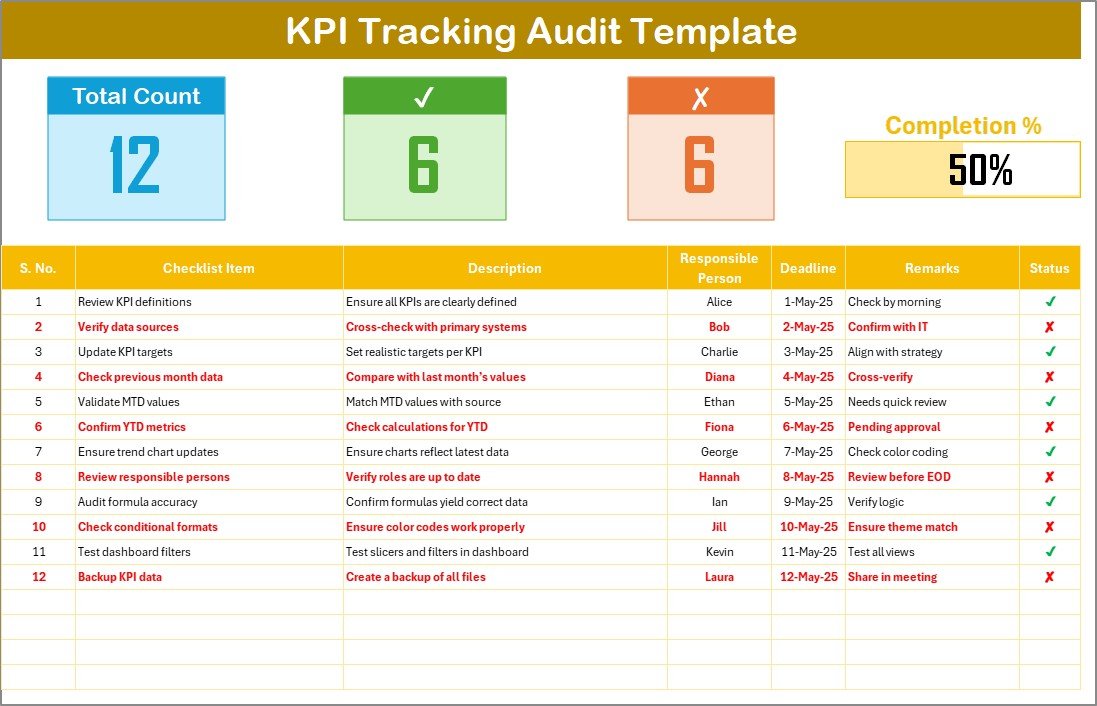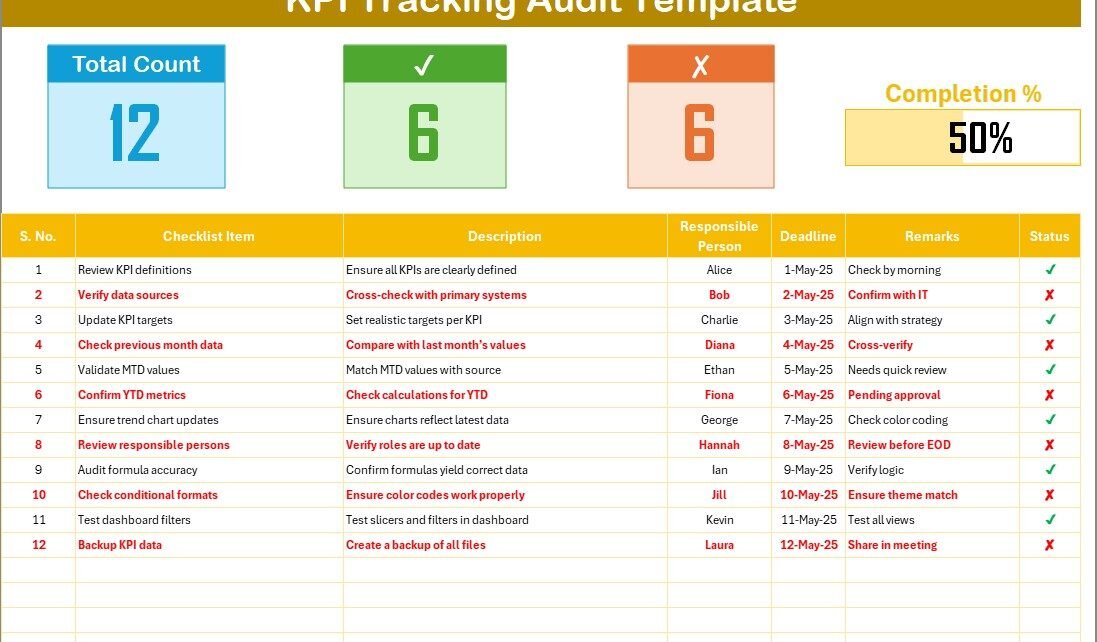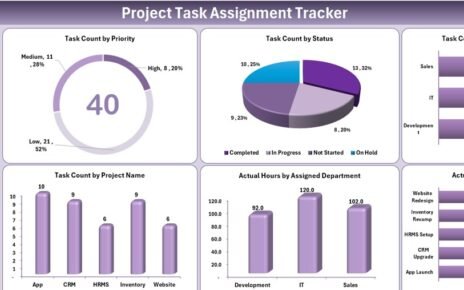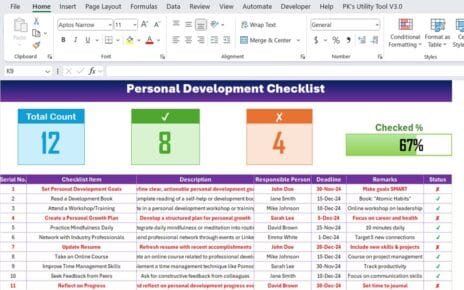Are you tired of chasing down missed deadlines or wondering who dropped the ball on key performance goals? If yes, then a KPI Tracking Audit in Excel might be exactly what you need. Whether you’re a project manager, team leader, or business owner, this powerful tool helps ensure accountability, improve efficiency, and promote continuous growth.
Let’s dive into how this Excel-based KPI Tracking Audit Checklist Template works, why it’s so effective, and how you can easily use it to transform your performance monitoring process.
Table of Contents
ToggleClick to Purchases KPI Tracking Audit in Excel
What is a KPI Tracking Audit?
KPI stands for Key Performance Indicator. A KPI Tracking Audit is a method of regularly checking whether team members or departments are meeting the KPIs set for them. It helps businesses identify:
-
Which goals are being met
-
Which areas are underperforming
-
Who is responsible for each KPI
-
Where improvements are needed
In simpler terms, this audit acts like a performance thermometer — giving you a real-time temperature check of how well your business functions.
Why Use Excel for KPI Tracking Audits?
You might wonder, “Why Excel?” After all, there are many tools out there. But here’s the truth:
✅ Excel is versatile
✅ It doesn’t require any software subscription
✅ Most users already know how to use it
✅ It allows full customization
With Excel, you have full control over your checklist, layout, visuals, formulas, and audit logic — all in one place. And the best part? You can automate many processes using formulas and conditional formatting without writing a single line of code.
Inside the KPI Tracking Audit Checklist Template
We’ve built a ready-to-use Excel checklist template designed to simplify your tracking process. This template comes with two well-structured worksheets:
1️⃣ KPI Tracking Audit Checklist Sheet Tab

This is the heart of the template. It contains:
➤ Top Section Summary Cards
At the top of the sheet, you’ll find three important cards:
-
Total Count – The number of items in the checklist
-
Checked Count (✔) – How many KPIs have been successfully met
-
Crossed Count (✘) – How many KPIs have failed
-
Progress Bar – A visual representation of your success rate
This section gives you an instant overview of how well you’re doing.
➤ The Checklist Table
Click to Purchases KPI Tracking Audit in Excel
Below the top cards lies the main audit table. Here, you’ll fill out the detailed checklist. It includes the following columns:
-
Serial No. – Auto-generated number for easy referencing
-
Checklist Item – The specific KPI or audit point
-
Description – A short explanation of the KPI
-
Responsible Person – The team member accountable
-
Deadline – When the KPI should be achieved
-
Remarks – Any important comments or observations
-
Status – Mark as ✔ (done) or ✘ (not done)
The beauty of this system lies in its simplicity and clarity. Anyone can read and update it without confusion.
2️⃣ List Sheet Tab

This tab acts as the data source for the Responsible Person dropdown list in the main checklist. Simply add unique team member names here, and they will appear in the dropdown menu in the primary sheet.
This way, you eliminate data entry errors and maintain consistency across your audit sheet.
How to Use the KPI Tracking Audit Checklist Template
Using this template is as easy as 1-2-3.
✔ Step 1: Fill in the KPI Items
Begin by entering each KPI or audit item into the “Checklist Item” column. Keep it clear and action-focused — for example, “Submit monthly financial report” or “Update CRM with client feedback.”
✔ Step 2: Assign Responsibility and Deadlines
Select a Responsible Person from the dropdown and enter a realistic Deadline. This promotes ownership and accountability.
✔ Step 3: Track the Status
Once the task is complete, mark it with a ✔. If not done or failed, use ✘. The top section will automatically update the progress bar and counts, giving you a bird’s-eye view of the audit.
Advantages of KPI Tracking Audit in Excel
Let’s explore the major benefits this tool brings to your workflow:
✅ Transparency and Accountability
Everyone knows who is responsible for what — reducing confusion and finger-pointing.
✅ Real-Time Progress Monitoring
Instant visual feedback through the progress bar and summary cards.
✅ Improved Productivity
When people see their progress, they feel more motivated to complete tasks on time.
✅ Easy to Customize
Add more columns, color-code tasks, or integrate it into larger dashboards — Excel allows it all.
✅ Cost-Effective Solution
You don’t need fancy software or tools. Excel does the job beautifully — no extra cost.
Best Practices for KPI Tracking Audit in Excel
To get the most out of your checklist template, follow these best practices:
📌 Keep Your Checklist Items Clear
Avoid vague terms like “Handle customer issues.” Instead, write “Resolve all customer complaints within 48 hours.”
📌 Regularly Update the Sheet
Set a time — daily, weekly, or monthly — to update the status. This builds a rhythm and keeps things current.
📌 Use Conditional Formatting
Color-code rows for ✔ and ✘ to make the sheet visually intuitive.
📌 Involve the Whole Team
Let each responsible person update their own status. This encourages ownership and saves the team leader’s time.
📌 Backup the File
Maintain version control to avoid accidental data loss. You can even use Google Sheets if collaboration is key.
How KPI Tracking Helps in Business Success
Still wondering if KPI tracking is really worth it? Here’s how it drives performance across the board:
-
Faster decision-making: With all data visible in one sheet, you no longer guess — you act.
-
Better team performance: Employees become more goal-focused and organized.
-
Error reduction: The audit format minimizes the chances of missing important KPIs.
-
Strategic growth: You can identify patterns, adjust strategies, and focus on what truly matters.
Common Mistakes to Avoid in KPI Auditing
Let’s be honest — even the best tools fail if you don’t use them properly. Watch out for these common mistakes:
🚫 Setting too many KPIs – Focus only on what’s truly important
🚫 Lack of follow-up – A checklist isn’t useful if no one reviews it
🚫 Assigning the same KPI to multiple people – This leads to confusion
🚫 Ignoring missed deadlines – Always discuss reasons and make improvements
🚫 Complex formatting – Keep the sheet clean and minimal
Avoiding these pitfalls ensures that your KPI audit becomes a source of strength — not stress.
How to Customize the Template Further
Want to make your KPI Audit Checklist even more powerful? Here are a few ways to do it:
-
Add filters to sort by status or responsible person
-
Use dropdowns for status to avoid manual entry
-
Insert a chart showing completed vs. pending KPIs
-
Add email reminders using Outlook or Google Workspace
-
Integrate with Power BI for interactive dashboards
Conclusion: Start Auditing KPIs with Confidence
In today’s fast-paced business environment, tracking KPIs is not optional — it’s essential. But you don’t need complicated software or expensive tools to do it. A simple, well-designed KPI Tracking Audit Checklist in Excel can make all the difference.
With visual summaries, smart dropdowns, and easy progress tracking, this template gives you the structure you need to stay ahead of deadlines and exceed performance goals.
So why wait? Download your KPI Tracking Audit Checklist template today and take the first step toward a more accountable and efficient team.
Frequently Asked Questions (FAQs)
❓ What is the purpose of a KPI Tracking Audit?
A KPI Tracking Audit helps monitor whether key performance goals are being met, by whom, and by when. It promotes accountability and boosts productivity.
❓ Can I use this Excel template for any industry?
Yes! The template is fully customizable and works well for any industry — including sales, marketing, HR, operations, IT, education, and more.
❓ How do I mark a task as completed in the checklist?
Simply enter ✔ in the “Status” column. This will update the progress bar and the summary counts at the top.
❓ What if I miss a deadline in the audit?
Use the “Remarks” section to explain why the deadline was missed. Then reassign a new deadline and track it again. The goal is improvement — not blame.
❓ Can I share this Excel checklist with my team?
Absolutely! You can share the file via email or upload it to Google Drive or OneDrive for team collaboration.
Click to Purchases KPI Tracking Audit in Excel
Visit our YouTube channel to learn step-by-step video tutorials
Watch the step-by-step video Demo:



